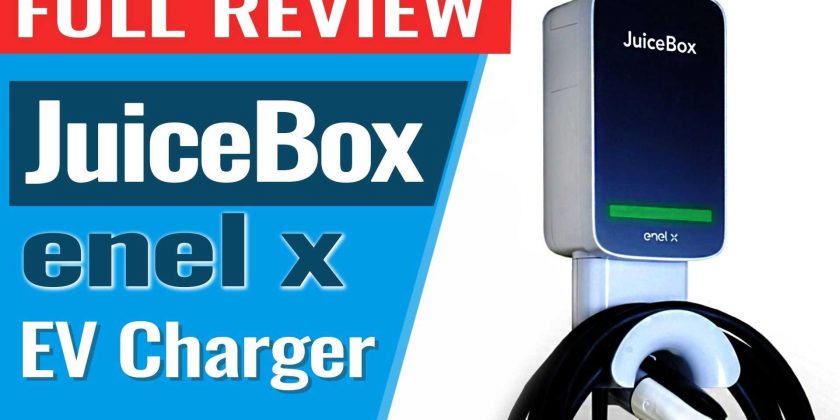We see how the JuiceBox stands up to our comprehensive testing review
After using the Enel-X JuiceBox EV charger for about 8 months now, we put it to the test in this video review, including comparisons and of course, our exclusive charger deep freeze test.
The Enel-X JuiceBox is available in 32, 40 & 48-amp versions, and other than the power rating, the units are identical. We chose to review the 40-amp version, which we believe will be the most popular one, based on its features, cost, and power output.
The New JuiceBox has a completely new look with an integrated connector holster and cable management loop.
The unit we reviewed is actually the second-generation of JuiceBox chargers and is a completely new unit that Enel-X began selling in early 2020. We liked the original JuiceBox EVSE a lot and reviewed it back in 2015. The new JuiceBox has all of the smart-charging features of the original JuiceBox, plus more, and it has an integrated connector holster and cable management loop.
The new, more stylish look of the JuiceBox included an LED bar across the bottom of the main unit that changes color depending on whether the car is currently charging, finished charging, or idle between charging events.
The JuiceBox is easy to install and only requires you to secure a long mounting bracket onto the wall. The JuiceBox then slides into the groves in the bracket which hole it into place. You then have the option of locking it in place and removing the key if needed. That won’t be necessary for most home garage installations, but for those mounting the JuiceBox outside their home, or in a garage that other residents have access to, having the ability to lock the unit to the wall is a very important option.
This also allows the JuiceBox to be removed quickly if needed. Other chargers that need to be securely attached to the wall cannot be quickly removed, because you need to open the unit up to remove the mounting screws that are inside the enclosure. Enel solved that issue with the locking mounting bracket, enabling the JuiceBox to be both easily removable and safely secured.
We also like to take a close look at the connectors used on the chargers and compare them to competing brands. The JuiceBox uses a connector made by ITT. It’s a popular choice among EVSE, and it’s a durable connector that can withstand abuse. While we don’t dislike the ITT connector, we do like the connectors used by ChargePoint and ClipperCreek a little more, because they have a softer rubberized grip, and feel a little more premium than the ITT connector does.
One of the things we do here that nobody else does when reviewing EV chargers is what we call our cable deep freeze test. We place the chargers in a commercial freezer overnight to replicate having the charger mounted outdoors in extremely cold winter conditions. After about 12 hours in the freezer, we take the charger out and see how easy the cable is to bend and manipulate. In the case of the JuiceBox, the cable was extremely stiff and unmanageable.
The JuiceBox’s cable actually performed the worst of all of the cables we’ve tested so far in the deep freeze test. For that reason, we can’t recommend the JuiceBox for outdoor installations in areas where the temperatures frequently drop below freezing. We think it would be a good idea for Enel-X to offer a cold weather cable as an option in the future.
The smart charging features of the JuiceBox is really where the unit excels. It has more of these features than any other charger available today. The JuiceBox’s app lets you adjust the power the charger delivers, so you can use it on a circuit that is less than the 50-amp circuit required to deliver the full 40-amps the unit can supply to the vehicle. It also is Amazon Alexa and Google Home compatible and can participate in utility demand response programs.
The JuiceBox also has a feature that few other chargers do, and that’s the ability to power share between more than one JuiceBox. This allows the user to share more than one JuiceBox on a single circuit. The JuiceBoxes will communicate with each other and ensure that they won’t overload the circuit. This makes charging two EVs at home more convenient and the chargers less expensive to install.
You can also schedule the JuiceBox to charge your EV at a set time to coincide with time-of-use utility rates, which can save a lot of money. We should mention that most EVs today already have that feature built into the car, but you then have to disable it when you’re using a public charger and can forget to reset the TOU schedule once you get home. If your home charger has the ability to schedule charging, you don’t need to fumble with in-car scheduling, and possibly forget to set it back later.
We’ll be reviewing all of the popular EV home chargers so we’ve created a point-based system called the ChargerRater. The ChargerRater five categories and in each category the EVSE starts out with 15 points. Points are then added or subtracted for features and performance. The total is then converted into a 5-Star score.
We then offer our own opinion of the equipment, also on a 5-star scale, and average the two scores. The Enel-X JuiceBox 40 received an excellent score of 89 points on our ChargerRater scoring system which equals 4.45 stars and finished up with a combined rating of 4.6 stars when averaged with our personal 5-star rating.
Check out the video review and let us know your thoughts on the Enel-X JuiceBox, as well as our rating system. As always, use the comment section below to let us know what you think.
Source:State of Charge
Source: Read Full Article







